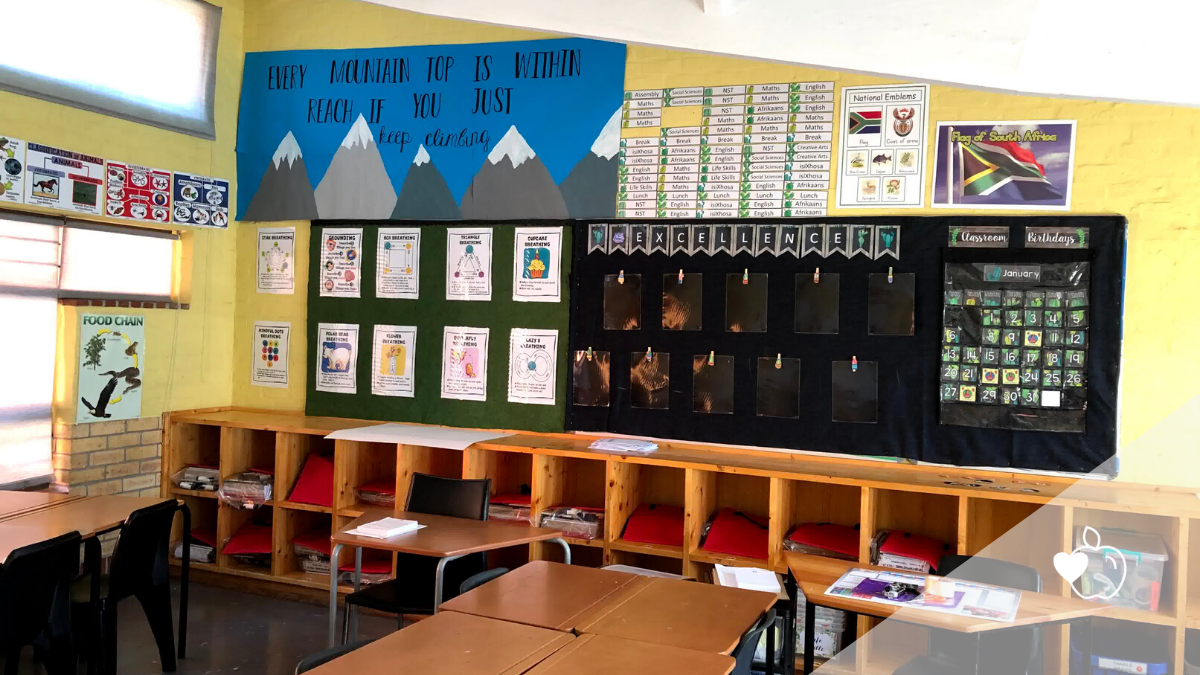Notes from a not-so-calm teacher, on how I created my calmest space in eight years.
I recently took a moment to reflect on a particularly manic day with my Grade 5s. It was a busy time of the term. Exams were coming up and we were pushing to finish the curriculum in time. I was anxious about it and my learners were picking up on that and acting out in their typical ways – I knew then that something had to change.
The research is clear. Anxiety in the classroom does not make for a good learning environment. This meant that all of my rushing and stressing in an attempt to get everything done, was having the exact opposite effect of what I wanted.
I thus decided to approach the planning for my classroom from two main angles: décor and procedures.
Classroom décor
General décor
Bright and colourful was out. I muted the colours in my class to blues, greys and a dash of pale yellow in what I referred to as my “zen nature” theme. I incorporated plants and pictures of mountains and because I will forever be a supporter of the Growth Mindset, I turned my students into little mountaineers and told them that we would climb the mountain together. The most important part for me was that the classroom environment needed to reflect how I wanted my students to feel – calm.
Posters
Informational posters were also a useful addition. I decided to reduce the number of posters after reading that having too many could be very overwhelming for learners. I focused on a few key skills that I wanted learners to be able to reference. This included a series of breathing activities and a poster with yoga poses. I also made sure to include my five classroom rules that I obtained from Whole Brain Teaching some time ago.
Classroom procedures
Once the feel of the classroom was right, I needed to plan the classroom procedures.
Setting clear expectations with natural consequences
The most crucial change that I’ve made towards a calm environment is making sure that the expectations are clear. Setting clear expectations means that learners can feel safe in their environment as there are consistent boundaries with predictable consequences.
Brené Brown, a research professor at the University of Houston, often refers to Choice Theory in her talks and books and this really resonated with me.
Choice Theory confirms that we all make our own decisions about our behaviour on a daily basis and those decisions have consequences. Therefore, when we choose to behave in a certain way, we choose the consequence that goes with it. A practical example would be that if a learner chooses to chat with a friend when they are supposed to be working, their work will not be finished. The natural consequence might be that they will need to stay in at break or after school to finish the work, as it is important that the work gets done. Having a natural consequence makes it easier to be consistent because the emphasis is on the learner’s choice and their level of control.
Having and being able to exercise choices in the classroom can have a really positive impact. I try as far as possible to give my learners multiple choices throughout the day. For example: where they sit, who they sit with and even sometimes the order in which they complete work. It’s crucial to have boundaries and a shared understanding of how we want the class to run for this to work. With choice comes the understanding that if my choices negatively impact others’ or my own learning, there are consequences.
Morning yoga
I am not a yoga person. I am the type of person who wants to be a yoga person, but never actually gets around to it. However, this is the year of new things – so I decided to try doing five yoga poses each morning with my learners. As we do each pose, we say each phrase together. I am strong. I am brave. I am kind. I am wise. I am friendly. This is a great way to come together in the morning as a class community and set the tone for the day ahead.
Daily Check-In
Once we have done our 5 minutes of yoga, we do a Daily Check In to see if anyone in the class has had a rough night or has had something happen that may affect them and their learning.
Brain Breaks and Breathing
Brain Breaks are crucial for keeping everyone in the class (including myself) awake and alert. We take regular Brain Breaks throughout the day to keep us on our toes. Our favourites are dances on YouTube (for example JustDance videos) or Go Noodle and simple meditation and breathing techniques on Cosmic Kids Yoga.
It’s been a term of our new and improved classroom and it is by no means perfect – we still have the odd manic moment. But the classroom is certainly a lot calmer, and despite us taking time out for things like yoga, brain breaks and daily check-ins, I have found that we are a lot more productive in reaching our learning goals.
This article was originally published in the Teacha! Magazine Issue 3.4.
Read the latest Teacha! Magazine here .









